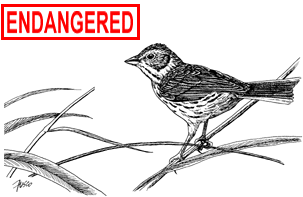Vesper Sparrow
Pooecetes gramineus

Habitat: Old fields, meadows, pastures, woodland clearings, and hayfields. Sometimes found in beach grass in coastal areas.
Weight: 0.75-1 ounce.
Length: 5.5-6.5 inches.
Wingspan: 10-11 inches.
Life Expectancy: Banding records have reported birds more than 6 years of age.
Food: Beetles, grasshoppers, caterpillars, moths, and large amounts of weed seeds and grains.
Status: State endangered.
Identification: The vesper sparrow is gray-brown and streaked above, dull white below, and streaked on the throat, breast, and sides. The tail is short and notched with white outer feathers that are conspicuous in flight. This sparrow also has a narrow, white eye ring, a dark ear patch outlined along the lower and rear edges with white, and a distinctive chestnut shoulder patch that is not easily seen. The song, which is rich and melodious, consists of 2 long, slurred notes followed by 2 higher notes, then a series of varied, short, descending trills.
Range: The vesper sparrow occurs from Canada south through the United States. It winters south to Mexico and the Gulf Coast states.
Reproduction: The vesper sparrow nests on the ground in dry, grassy areas. The nest is a small depression made by the sparrow, lined with fine materials, and located near sparse patches of vegetation. The 3 to 5 eggs are smooth, slightly glossy and white, marked with brown. The eggs are usually incubated by the female for 11 to 13 days. The altricial (helpless) young have flesh-colored skin, gray down and a deep pink mouth. They leave the nest 7 to 13 days after hatching, but are unable to fly well. They remain dependent on the adults for about 3 more weeks. Vesper sparrows occasionally raise 2 clutches during the nesting season.
Reason for Decline: With the disappearance of farmlands and open fields and the increase in residential and commercial development, populations of vesper sparrows have declined. As with other ground-nesting birds, high numbers of predators, such as raccoons and skunks, have also contributed to the decline of this species.
History in Connecticut: Vesper sparrows were considered abundant nesters throughout Connecticut in the mid-1800s, but populations have been scarce in Connecticut since the early 1900s. Since the 1940s, this species' nesting range has shrunk rapidly in the state due to development and changes in agricultural practices. Vesper sparrows are now seen occasionally in the agricultural uplands in the northern part of the state. Recent nesting attempts in Connecticut have been recorded at grasslands surrounding airports and in open fields. However, actual nesting has not been confirmed in the state since 1984.
Interesting Facts: To announce its territory, the male vesper sparrow usually sings from the highest perch available. Where there are no trees, it will use fence posts, tall weeds or shrubs.
The vesper sparrow gets its name from its habit of singing in the late afternoon and early evening; although, during the nesting season, the bird sings at all times of the day.
Ironically, vesper sparrows often do best where agricultural crops do worst: sandy, rocky soils with patchy vegetation.
Vesper sparrows are a host of the parasitic cowbird, which lays its eggs in the sparrows' nests. The "host" vesper sparrows end up raising the larger cowbird young, while their own young usually perish.
Hybridization between vesper sparrows and field sparrows was documented in 1958.
Protective Legislation: Federal - Migratory Bird Treaty Act of 1918. State - Connecticut General Statutes Sec. 26-311.
What You Can Do: Protection of open grassland areas is essential for maintaining breeding populations of vesper sparrows. Keeping fields open and free of woody vegetation is critical. Altering hayfield mowing practices or harvest schedules can provide continued use of hay, maintain the open habitat, and prevent the accidental destruction of nests or young during the breeding season.

The production of this Endangered and Threatened Species Fact Sheet
Series is made possible by donations to the Endangered Species/Wildlife Income Tax
Checkoff Fund.
(rev. 12/99)

